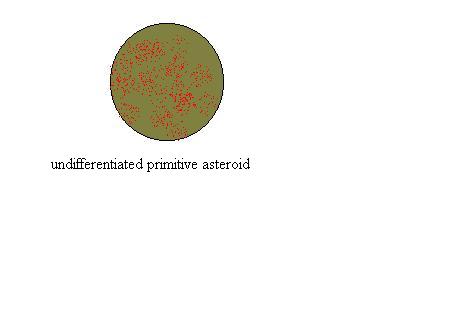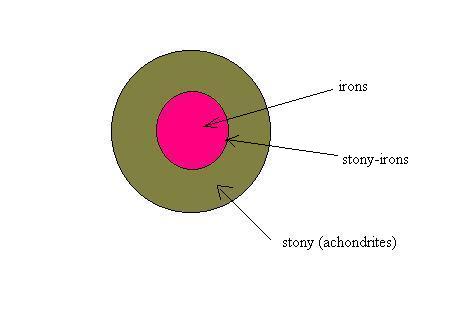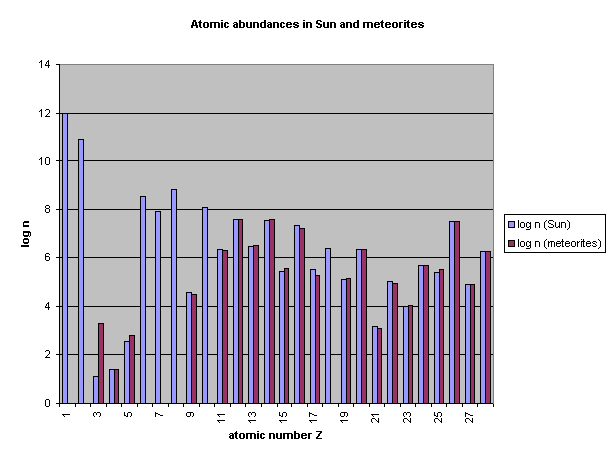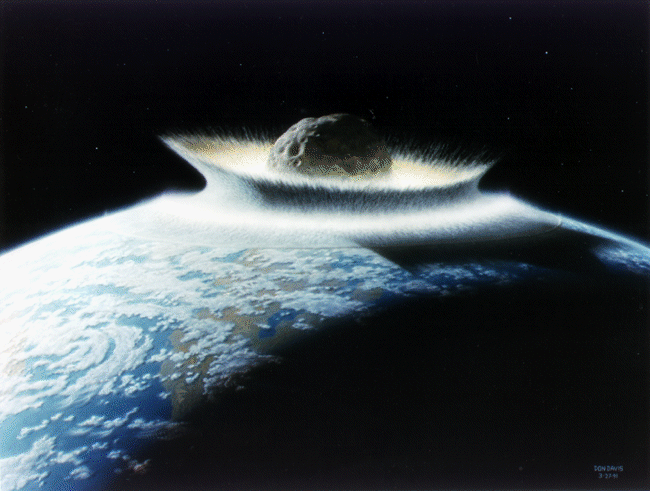
April
22 Lecture
The Impacts of Comet Shoemaker-Levy 9 on Jupiter
This series of events occurred on July 16 through July 22, 1994. This was the first time in history that humans were able to witness, in detail, the impacts of large solid objects onto a planet. The short-period comet had been captured by Jupiter, and had passed within Jupiter's Roche limit the previous year, splitting into a couple-dozen nuclei, each a few km in size. The next time the string of nuclei approached Jupiter, in 1994, they hit its south-polar region.
Here is a web site with many images.1 km = 105 cm, so 1 cubic km = 1015 cm3.
Assuming that the fragments were mostly ice, they would have had a density of 1 gram/cm3, so a typical fragment would have a mass of 1015 g.
Now let's calculate the kinetic energy of a fragment as it hits Jupiter's atmosphere. Remember that the formula for kinetic energy is
KE = (1/2) mv2
When a fragment hits Jupiter's atmosphere, it is traveling at about escape velocity for Jupiter, v = 60 km/s = 6 x 106 cm/s, so we get for the kinetic energy
KE = (1/2) x 1015 x (6 x 106)2 = 1.8 x 1028 erg
How big is this number? The explosive TNT releases 4.2 x 1010 ergs per gram when it goes off. A truck bomb like the ones used by terrorists have about a ton of TNT, which would be 1000 kg = 106 g. This would release 4.2 x 1016 ergs. A tactical nuclear weapon has an explosive yield equal to a kiloton of TNT, or 4.2 x 1019 ergs. A big hydrogen bomb has an explosive yield equal to about 10 megatons of TNT, or 4.2 x 1023 ergs. So each of the SL9 impacts would have released an energy equivalent to about 40000 big hydrogen bombs. This is somewhat bigger than the maximum explosive energy that could have been released in a full-scale nuclear war between the USA and the USSR.
What happens when we have a hot bubble in a planet's atmosphere as a result of an explosion?
First, a small explosion, with a fireball whose size is much less than a scale height:

The characteristic mushroom cloud is an example of a Rayleigh-Taylor instability.
If the fireball is much bigger than H, the explosion punches right out of the atmosphere, producing ballistic ejecta. This is what happened with the SL9 impacts. The explosive plumes rose about 4000 km above the planet's atmosphere:

Link to simulations
Meteorites are solid specimens of
objects from elsewhere in the solar system. They are
recovered on the surface of the Earth, after surviving
high-speed entry through the atmosphere. Our basic
information about solar system abundances comes from meteorites
as well as from the Sun. In a moment we will look at a
chart of abundances determined from meteorites, compared with
the Sun.
Types of Meteorites
Meteorites are thought to originate from parent bodies analogous to the main types of asteroids: undifferentiated primitive bodies, and from differentiated (iron core and rocky, iron-depleted mantle) asteroids.
The undifferentiated parents of meteorites such as carbonaceous chondrites (defined below) look like this:

The other types of meteorites come
from different regions within a differentiated (less-primitive)
parent body:

How long do these samples stay in
space? We can date the residence time in space using
cosmic-ray tracks, little trails of damage left in the surfaces
of the meteoroids while they are exposed to cosmic rays outside
the Earth's atmosphere. Typical times in space are about
107 years for the chondrites, and considerably
longer, more than 108 years for irons.
The Age of the Solar System
The age of the solar system is, in round numbers, 4.57 gigayears. What do we mean by this age? It is established from the most primitive meteorites, carbonaceous chondrites, and is the time that has elapsed since they became closed specimens. The age of the specimens is determined from the abundances of isotopes with radioactive parents such as potassium-40 and uranium-238.
It is a curious fact that the solar system was a much more radioactive place when it was forming than it is today. There is evidence in CAIs (defined below) in carbonaceous chondrites for short-lived radioactive isotopes, including the fairly abundant isotope aluminum-26.
We find daughter isotopes of the
following parents:
I129 (half-life = 1.6 X 107
years)
Pu244 (half-life = 8.2 X
107 years)
AI26 (half-life = 1 X 106
years)
These, along with the longer-lived isotopes, were produced in long-ago stellar explosions, thrown into space, and then incorporated in planetesimals when our solar system was forming.
This should be distinguished from
Meteor, the visual phenomenon of a "falling star" seen in the Earth's atmosphere.
Most meteors are produced by objects only about a millimeter in size or smaller, which burn up on entry and never reach the Earth's surface.
Meteorites are further classified as
Finds, meteorites recovered from the Earth's surface but which were not observed to fall and therefore don't have entry dates,
and
Falls,
which were seen as meteors before being recovered.
The broad types of meteorites are
Chondrites, the most primitive and relatively undifferentiated meteorites. These are thought to come from the most primitive undifferentiated asteroids.
Achondrites, meteorites that are formed by a process of melting (volcanism), and are therefore more evolved. They are depleted in iron.
Stony-irons, meteorites that have, together, separate phases of iron and silicate melt products. These are relatively rare, and may come from the interface between the iron core and the silicate mantle of the meteorite's parent body.
Irons, meteorites that come from the cores of the parent bodies.
We will look at actual examples of all of these in class, except for stony-irons (click here for pictures of stony-irons).
The prototype for the most primitive type of meteorite of all, the carbonaceous chondrite, is a famous fall in the Mexican state of Chihuahua in February, 1969. The meteorite is named after the village where it fell, Allende. We looked at a piece of Allende in class. Here is a diagram of the general appearance of a carbonaceous chondrite:

For scale, the chondrules are typically about 1 mm in size or smaller. Carbonaceous chondrites are depleted in volatile elements relative to solar composition, but only the most volatile elements such as H, He, C, N, O, Ne, Ar, etc. (see diagram below).

We also looked at a eucrite (achondrite). Planetary scientists suspect that this volcanic meteorite came from the asteroid Vesta, which shows evidence of volcanic processing. This is a mystery because asteroids are too small to develop enough radioactive heating for volcanism. Something else, early in the history of the solar system, seems to have caused the melting.
We looked at an iron meteorite from an impact site near Odessa, Texas. These are the most durable and easily recognized of all meteorites. One such meteorite (a piece of the impactor from the Arizona Crater impact site!) is on display inside the Flandrau Planetarium next door. The so-called Arizona Meteor Crater was produced by an impact of this iron object (see below).
We know that iron meteorites come
from the iron cores of differentiated asteroids, because the
iron, when sawed, polished, and etched, shows Widmanstaetten
patterns, beautiful and intricate
cross-cutting phases of nickel-rich and nickel-poor phases of
iron. These phases cannot be produced in a laboratory, because
they can only arise when the iron is very slowly cooled at a
rate of about 10 K per million years! This is just the
right cooling rate for the core of an asteroid that is a few
hundred km in size.
SNC Meteorites and Lunar Meteorites
In addition to the meteorites mentioned above, all of which mainly come from asteroid parent bodies, there are (rare) meteorites that are, in effect, free samples from other planets: http://www.jpl.nasa.gov/snc/
The SNC meteorites are a class of meteorites that come from Mars. They were apparently ejected into escape orbits from the Martian surface by impact events, orbited in interplanetary space for a time, and then impacted the Earth. They are named for their prototypes, Shergotty, Nakhla, and Chassigny. More recent examples of SNC meteorites have been recovered from Antarctic ice fields. The conclusive proof that SNC meteorites come from Mars is the fact that some of them contain gaseous inclusion of argon, krypton, and xenon isotopes that are a close match to the composition of Mars' atmosphere! SNC meteorites are composed of rocks that typically solidified about 1 Gyr ago, far too recent to correspond to volcanism on asteroids, but a reasonable age for Mars.
A few meteorites recovered in
Antarctica prove to be a close match to lunar samples, and are
therefore clearly from the Moon.
Impacts on Earth
Earth's atmosphere screens out small
objects, but anything bigger than about a kilogram can make it
to the surface, and objects that are bigger than about a metric
ton (1000 kg) can create an impact crater.
Here are some approximate times between impact events:
diameter of impactor in
meters
impact interval in years
3
1
30
100
100
3000
1000
1 million ?
10000
100 million ?
The most famous impact crater is right here in Arizona. It was created by an iron meteorite about 50 m in diameter, about 50000 years ago (before there were humans in Arizona). The impact released about 20 megatons of TNT worth of energy (equivalent to a large thermonuclear warhead). In the floor of such impact craters, one finds breccia and shock-produced glass particles.
There are quite a number of older impact craters on Earth.
In 1980, the physicist Luis Alvarez and his geologist son, Walter Alvarez, shocked the scientific community by proposing a theory that the age of the dinosaurs was brought to an end 65 million years ago by a huge impact event.
The dinosaurs were one of the most spectacular and successful life forms that ever existed on Earth. These huge reptilian creatures dominated the Earth throughout the Mesozoic era (245 m.y.a. to 65 m.y.a.).
Nomenclature: (most recent at top, oldest at bottom) Cenozoic
Era (65 m.y.a. to present)
Quaternary Period (1.6. m.y.a. to
present)
Tertiary Period (65 m.y.a. to 1.6 m.y.a.)
ABRUPT TRANSITION HERE
Mesozoic
Era
Cretaceous Period
Jurassic Period
Triassic Period
The genus homo (includes us and extinct close ancestors) has only been present in the Earth's environment since around the start of the Quaternary.
The transition from the Cretaceous period (K) to the Tertiary period (T) is sometimes called the K/T boundary. Geologically, it is very abrupt. The fossil record shows that not only did the dinosaurs disappear forever at this point, but vast numbers of other species, both marine and land-based, disappeared at the same time. Something very dramatic happened to the Earth.
The Alvarezes discovered that there is a thin (~ cm-thick) layer of clay between the T and K deposits, and that there is a large amount of iridium in this layer, worldwide. They calculated the size of an asteroid that could deposit that much extra iridium and found that it would have a diameter of about 10 km! Other excess siderophile elements have since been found in this layer, such as platinum, osmium, and gold.
Iridium (chondritic) / Iridium
(Earth's crust) = 1430
Platinum (chondritic) / Platinum
(Earth's crust) = 587
Gold (chondritic) / Gold (Earth's
crust)
= 104
An asteroid this size would have left a huge crater, bigger than 100 km in diameter. It wasn't found right away, which left the Alvarez theory in doubt.
How big would the explosion have been? Let's use the formulas from the SL9 calculation:
1 km = 105 cm, so 1 cubic km = 1015 cm3. Radius of the asteroid = 5 km, so its volume = 4 pi r3/3 = 524 cubic kilometers = 524 x 1015 cm3.
It is thought that the K/T asteroid was a carbonaceous chondrite with a density of 3.5 gram/cm3, so its mass was 1.8 x 1018 g.
Now let's calculate the kinetic energy of the asteroid as it hits Earth. Remember that the formula for kinetic energy is
KE = (1/2) mv2
When the asteroid hits Earth, it is traveling at at least escape velocity for Earth, v = 11 km/s = 1.1 x 106 cm/s, so we get for the kinetic energy
KE = (1/2) 1.8 x 1018 x (1.1 x 106)2 = 1.1 x 1030 erg
This is equivalent to about two million big hydrogen bombs!
Here is what Earth looked like 65
million years ago:

Artist's conceptions of the impact
and resulting crater:

The impact site, many years later:

Two petroleum geophysicists finally found the crater in Mexico. The geophysicists were Glen Penfield (from Houston) and Antonio Camargo (Pemex). The crater site is near Chicxulub ("devil's tail" in Mayan) in the Yucatan. It is a huge (180 km diameter) multiring crater, buried under Tertiary sediments.
The aftermath of the impact: